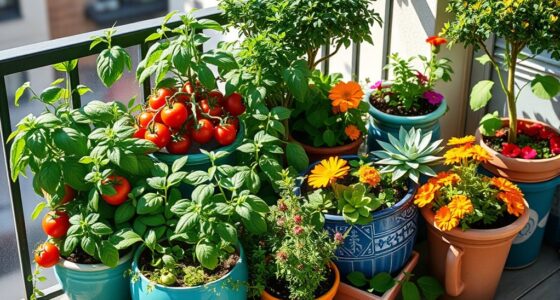Companion planting is a natural way to grow plants together, helping each other thrive by deterring pests and improving soil health. You can combine herbs, vegetables, and flowers to create a balanced garden that’s more sustainable and productive while reducing the need for chemicals. By understanding classic pairings and what to avoid, you’ll set yourself up for success. Keep exploring to discover simple ways to start and make the most of companion planting in your garden.
Key Takeaways
- Companion planting involves growing different plants together for mutual benefits like pest control and soil improvement.
- It has ancient roots across various cultures, blending traditional knowledge with modern science.
- Certain plant pairings, such as tomatoes with basil or beans with corn, enhance growth and soil health.
- Using specific plants like marigolds and basil naturally repels pests, reducing chemical use.
- Planning involves grouping plants by needs, avoiding incompatible combinations, and rotating crops for soil health.
What Is Companion Planting?
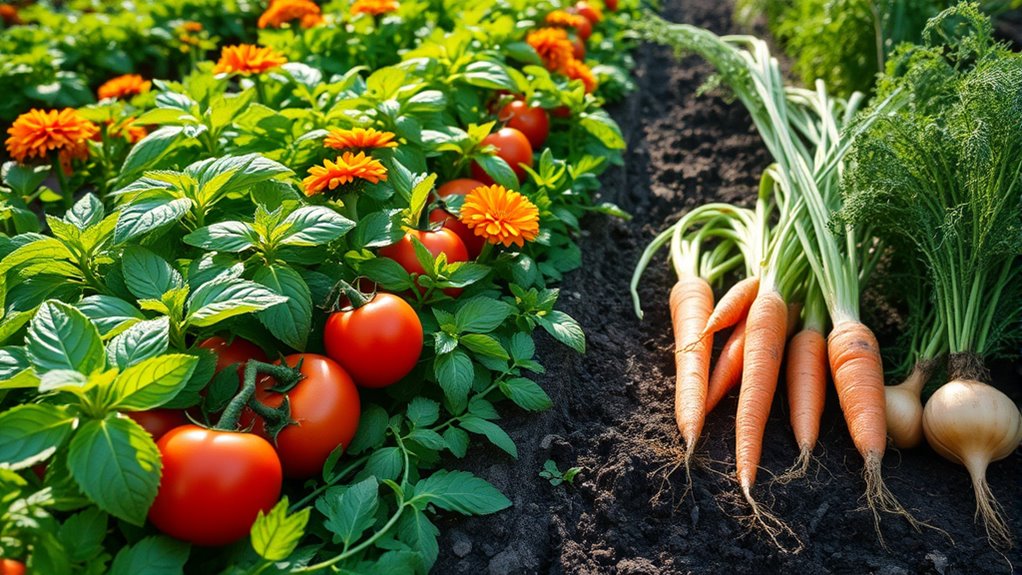
Companion planting is a gardening method where you grow different plants together to benefit each other. It’s about pairing plants that support growth, repel pests, or improve soil health. For example, planting marigolds near vegetables can deter pests, while beans fix nitrogen in the soil, helping nearby plants thrive. This approach reduces the need for chemical pesticides and fertilizers, making your garden more sustainable. You choose combinations based on how plants naturally interact, creating a balanced ecosystem. Companion planting isn’t just about mixing plants randomly; it’s about strategic pairings that promote healthier, more productive gardens. By understanding these relationships, you can enhance your garden’s health and yield without relying heavily on external inputs. Additionally, selecting the right plant combinations can optimize growth conditions and improve overall garden productivity, especially when using innovative planters designed to support diverse plant needs. It’s a simple, effective way to work with nature instead of against it.
The History and Origins of Companion Planting
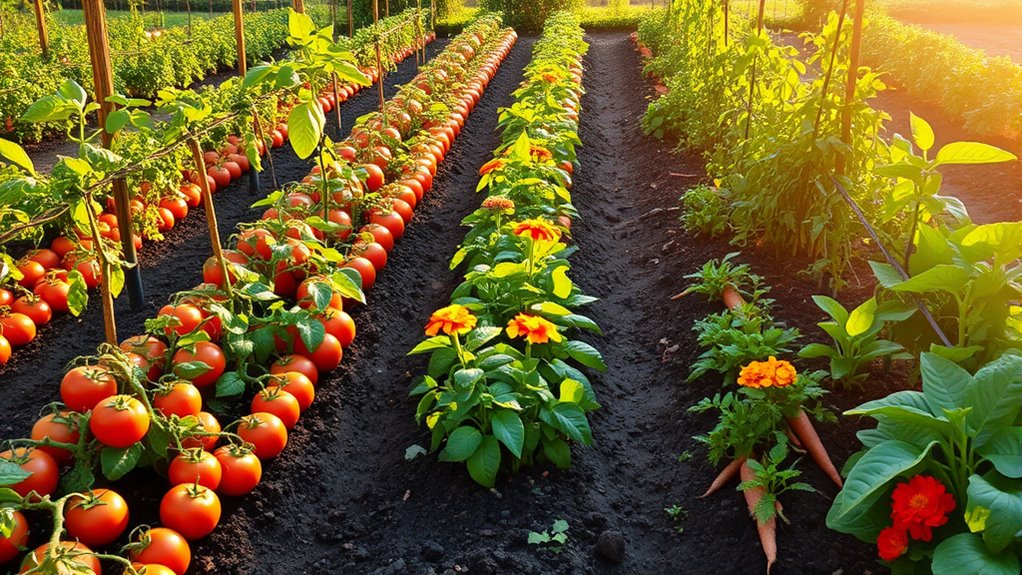
Ancient farmers and gardeners have practiced companion planting for thousands of years, relying on their observations of plant interactions to improve crop yields and pest control. In many cultures, such as Chinese, Indian, and Mediterranean societies, farmers noticed which plants thrived together and which didn’t, passing this knowledge down through generations. Traditional Chinese agriculture, for example, used crop combinations to enhance soil health and defend against pests. Similarly, Indigenous peoples in North America used plant pairings to promote growth and protect crops. These early practices weren’t based on scientific understanding but on trial, error, and keen observation. Over time, these indigenous and traditional methods formed the foundation for modern companion planting, blending empirical knowledge with evolving gardening techniques. Understanding self watering plant pots and their benefits can further support successful planting strategies.
How Companion Planting Works to Support Plant Growth

Companion planting helps your garden thrive by naturally controlling pests and reducing the need for chemicals. It also improves soil health and creates better conditions for your plants to grow strong. By choosing the right combinations, you set your garden up for healthier, more productive plants. Understanding the father-daughter bond can inspire gardeners to nurture their plants with love and patience, fostering a thriving garden environment. Incorporating soil enrichment techniques can further enhance plant growth and resilience. Implementing email marketing tools can streamline communication with fellow gardeners and promote community sharing of successful planting strategies. Proper GMC tuning methods can optimize your vehicle’s performance, much like selecting the right plant pairings enhances garden health. Additionally, understanding how performance upgrades influence overall plant vitality can help gardeners make informed choices for their garden’s success.
Natural Pest Control
Have you ever wondered how certain plants can naturally keep pests at bay? Companion planting achieves this by using specific plants to repel or distract pests from your main crops. For example, marigolds emit strong scents that deter aphids and nematodes, while basil repels mosquitoes and flies. Aromatic herbs like thyme and oregano also confuse pests, making it harder for them to find their targets. Some plants attract beneficial insects such as ladybugs and predatory wasps that feed on harmful pests. By strategically placing these companions, you create a natural pest management system that reduces your reliance on chemicals. Additionally, understanding plant symbiosis can help gardeners plan planting schedules during optimal times for pest control. Recognizing the importance of biological diversity within your garden can further enhance pest control efforts. This approach not only protects your plants but also encourages a healthier, balanced garden ecosystem.
Improved Soil Health
When you plant certain species together, they can enhance soil fertility and structure, creating a healthier environment for your crops. For example, legumes like beans and peas fix nitrogen in the soil, enriching it naturally. Companion plants such as marigolds can suppress harmful soil-borne pests and improve soil quality by reducing pathogen buildup. Additionally, diverse plant roots help prevent soil erosion and encourage beneficial microbial activity. Some plants, like cover crops, add organic matter when they decompose, boosting soil nutrients. By pairing plants thoughtfully, you create a balanced ecosystem that supports nutrient cycling and improves soil health over time. This foundation allows your crops to grow more vigorously, with better access to essential nutrients, ultimately leading to healthier, more productive plants. Incorporating cover crop systems can further enhance soil structure and fertility, promoting sustainable growth.
Enhanced Growth Conditions
By planting certain species together, you can create a microenvironment that enhances overall plant growth. Companion plants can regulate temperature, humidity, and airflow around your garden, reducing stress on your plants. For example, taller plants provide shade, preventing sunburn, while dense foliage can increase humidity levels, benefiting moisture-loving plants. Some companions release natural acids or nutrients that boost soil quality directly around their neighbors. Additionally, certain plants attract beneficial insects that ward off pests or pollinate flowers, leading to healthier, more productive crops. This harmonious environment minimizes disease and pest issues, allowing your plants to focus energy on growth rather than defense. Incorporating vetting essential oils known for their natural pest-repellent properties can further enhance the health of your garden ecosystem. Understanding companion planting principles can help you select the most effective plant combinations for your specific garden needs. For instance, integrating plants that are known to attract pollinators can significantly improve fruit and vegetable yields. Moreover, choosing plants with complementary root systems can improve nutrient uptake and reduce competition for resources. Recognizing the importance of soil health is essential for maintaining long-term productivity and resilience in your garden. Overall, choosing the right companions creates ideal conditions, helping your garden thrive naturally and reducing the need for artificial interventions.
Common Companion Planting Combinations for Beginners
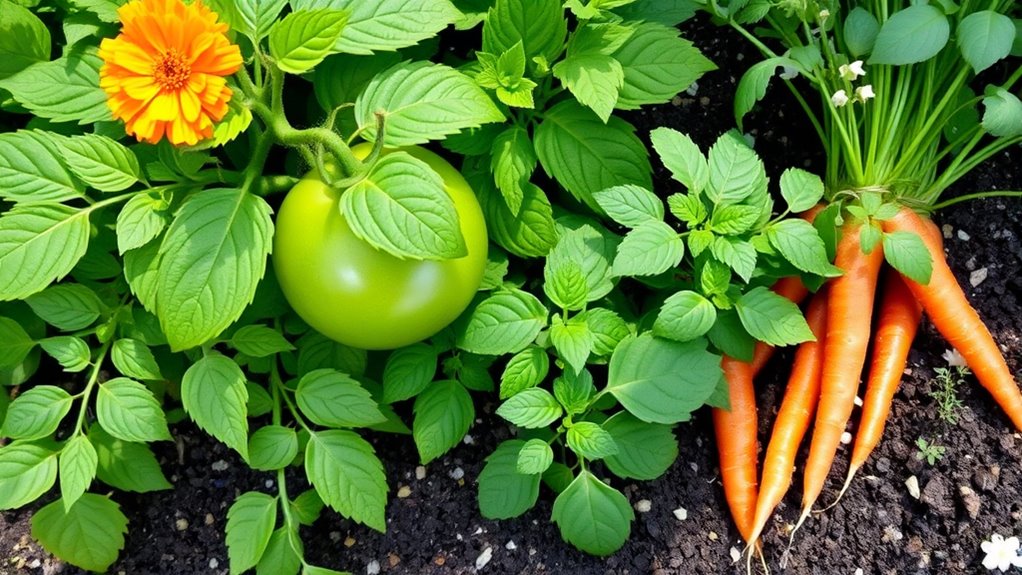
Starting with classic pairings like tomatoes and basil can boost growth and flavor, making your garden more productive. You can also plant marigolds near peppers to help repel pests naturally. These simple combinations give beginners a strong foundation for successful companion planting.
Classic Pairings for Growth
Classic companion planting pairs are a great way to boost your garden’s productivity and health, especially if you’re just getting started. These tried-and-true combinations support growth and improve soil health. For example, planting tomatoes with basil enhances flavor and repels pests. Similarly, carrots grow well alongside onions, which help deter pests. Some pairs, like beans and corn, benefit from mutual support—beans fix nitrogen in the soil, aiding corn growth. Here’s a quick look:
| Pairing | Benefit |
|---|---|
| Tomato & Basil | Enhances flavor, repels pests |
| Carrots & Onions | Deters pests, promotes healthy root development |
| Beans & Corn | Nitrogen fixation, structural support |
Sticking with these classic combinations can simplify your gardening journey while maximizing your harvest.
Pest-Repellent Plant Combinations
Many popular companion plant pairings also serve as natural pest repellents, making them perfect choices for beginners looking to protect their garden without chemicals. Marigolds are a prime example, as they repel nematodes, aphids, and certain beetles. Basil, when planted near tomatoes, can deter mosquitoes and flies, while mint naturally repels ants, moths, and cabbage worms. Nasturtiums act as trap crops, attracting aphids and whiteflies away from vegetables. Dill and cilantro also help keep pests like aphids and spider mites at bay. Incorporating these plants into your garden creates a natural barrier against common pests, reducing the need for chemical sprays. Plus, they often attract beneficial insects that prey on pests, creating a healthier, more balanced garden ecosystem. Understanding pest repellents can help gardeners optimize their plant combinations for better pest control. Additionally, selecting plants that support garden biodiversity enhances the overall resilience of your garden against pests and diseases. Recognizing the beneficial insect attraction of certain companion plants can further improve pest management strategies in your garden.
Plants to Avoid Putting Together
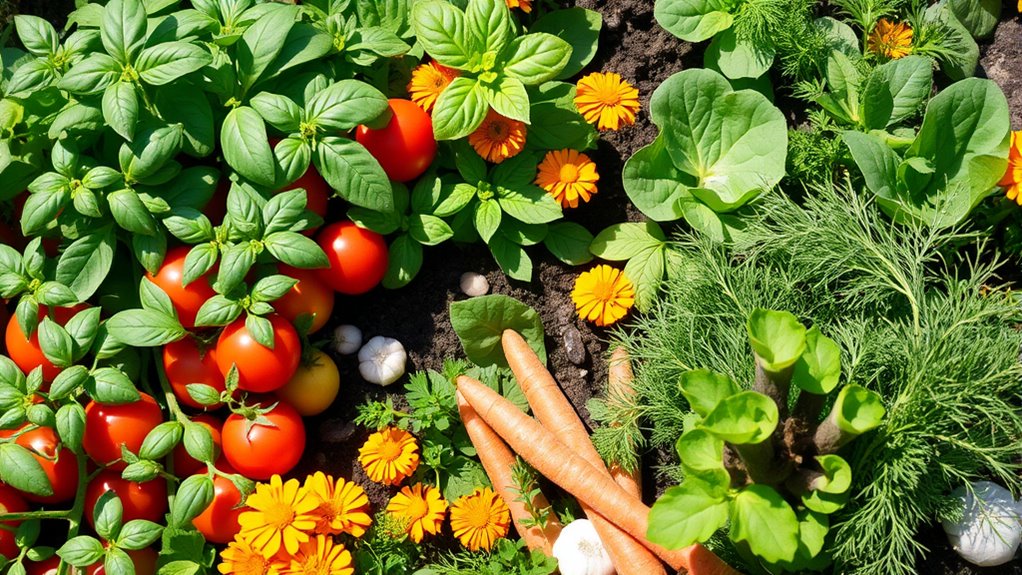
Certain plant combinations can hinder each other’s growth or attract pests, so it’s important to know which plants to avoid planting together. For example, don’t plant onions near beans, as onions can stunt bean growth. Similarly, avoid planting tomatoes with cabbage or broccoli because they attract similar pests, increasing the risk of infestations. Corn and tomatoes shouldn’t be neighbors either, since they both attract the same pests like corn earworms and tomato hornworms. Additionally, avoid placing potatoes near carrots, as potatoes release compounds that can hinder carrot growth. Be cautious about planting fennel with most herbs or vegetables; fennel tends to inhibit their growth. Understanding these pairings helps you prevent problems before they start, ensuring healthier plants and a more successful garden. Incorporating knowledge about plant compatibility can further improve your garden’s success rate. Moreover, considering indigenous wisdom about natural plant relationships can guide more sustainable and harmonious planting practices.
Tips for Planning Your Companion Garden
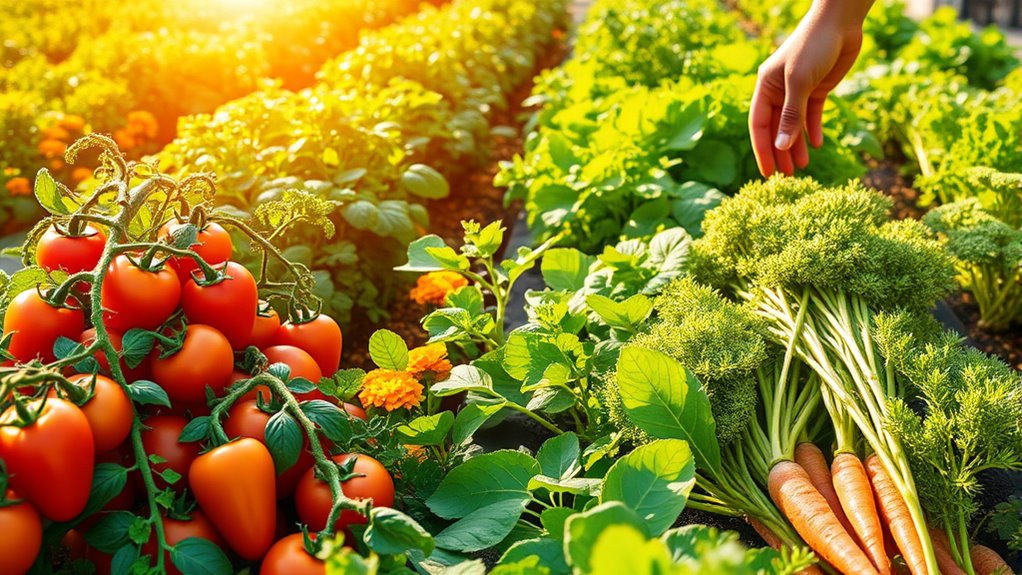
Planning your companion garden starts with understanding how different plants interact and arranging them strategically. Consider which plants naturally support each other’s growth and which might compete or repel. Group plants based on their needs—sunlight, water, and soil type—to optimize conditions. Use companion tables to guide your layout, ensuring beneficial pairs are placed near each other. For example, basil with tomatoes or marigolds with peppers. Think about plant height and spacing to prevent overcrowding. Rotate crops seasonally to maintain soil health. Keep pathways clear for easy access and maintenance. Here’s a helpful visual:
| Plant A | Plant B |
|---|---|
| Tomato | Basil |
| Marigold | Pepper |
| Carrot | Onion |
| Lettuce | Radish |
| Bean | Corn |
This structure promotes healthy growth and maximizes space.
Benefits of Companion Planting for Pest Control and Soil Health

Companion planting offers natural defenses against pests and enhances soil health, reducing the need for chemical interventions. By pairing plants strategically, you can attract beneficial insects that prey on common pests, like ladybugs against aphids or parasitic wasps for caterpillars. Certain plants also emit scents that repel harmful insects, keeping your garden healthier. Additionally, some companions improve soil quality by fixing nitrogen or preventing erosion, which supports overall plant growth. For example, planting beans with corn benefits both by enriching the soil and providing mutual shade. This natural approach minimizes pesticide use, making your garden safer and more sustainable. Understanding the importance of regular maintenance can further ensure your garden remains healthy and productive. Overall, companion planting creates a balanced ecosystem where pests are kept in check and soil remains fertile, leading to healthier plants and better yields. Incorporating knowledge from Advanced Techniques can further optimize your companion planting strategies for maximum benefits.
Getting Started: Simple Steps to Incorporate Companion Planting
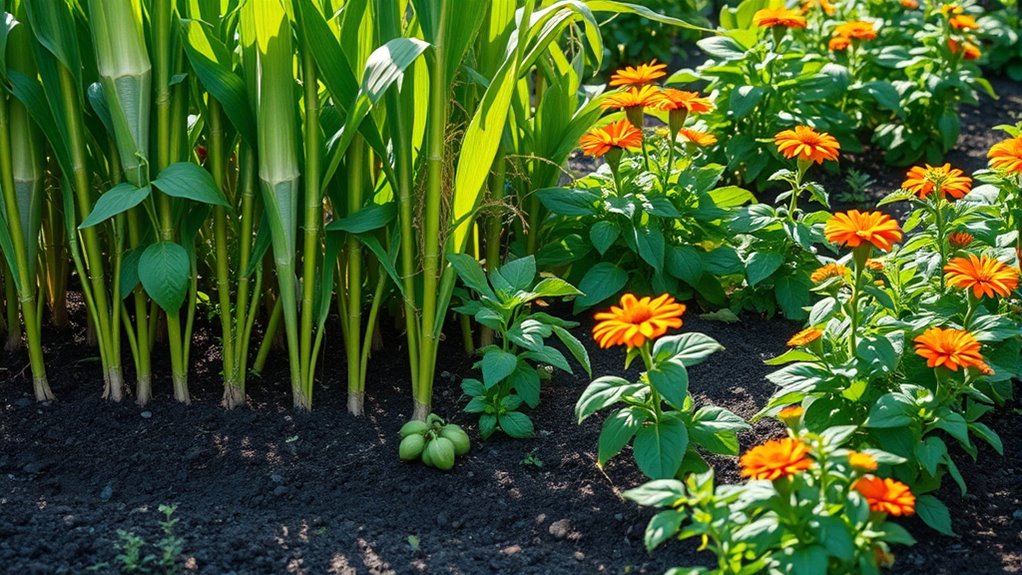
Getting started with companion planting is simpler than you might think. Begin by choosing a few easy-to-grow vegetables or herbs, like tomatoes, basil, or carrots. Research which plants naturally support each other’s growth and repel pests. Next, plan your garden layout, grouping compatible plants together. Use existing garden space or containers to experiment without committing to a large area. Keep notes on what works and what doesn’t, so you can refine your approach over time. Water and care for your plants as usual, but pay attention to how they interact. As you gain confidence, expand your garden, trying new plant combinations. Remember, even small steps make a difference, and companion planting becomes more intuitive with practice.
Frequently Asked Questions
Can Companion Planting Improve Crop Yields Significantly?
You might wonder if companion planting can boost your crop yields. It certainly can, as it helps reduce pests, improve soil health, and optimize space. By pairing plants that support each other, you create a healthier environment that encourages growth. While it’s not a guaranteed miracle, many gardeners see significant improvements when they strategically plant companions. So, give it a try and see how your crops benefit!
Are There Specific Companion Plants for Container Gardening?
Like a well-choreographed dance, container gardening benefits from specific companion plants. You can pair basil with tomatoes to boost flavor and repel pests, or marigolds with vegetables to deter insects. Herbs such as chives and parsley also thrive alongside various veggies. Choose plants that share similar water and light needs, and you’ll create a harmonious environment that enhances growth, health, and productivity in your container garden.
How Does Companion Planting Affect Plant Disease Resistance?
You might wonder how companion planting impacts plant disease resistance. When you plant certain companions together, they can naturally ward off diseases by improving airflow, reducing pests, and promoting healthy soil. For example, marigolds repel harmful nematodes, helping nearby plants stay healthier. By choosing the right combinations, you actively boost your garden’s resilience, decreasing the need for chemical treatments and creating a more balanced, disease-resistant environment.
Is Companion Planting Suitable for Organic Gardening Practices?
Yes, companion planting suits organic gardening well because it naturally enhances plant health and pest control without chemicals. You’ll find that pairing certain plants can boost growth, deter pests, and improve soil fertility, aligning perfectly with organic principles. By choosing your plant partners wisely, you create a balanced ecosystem that reduces the need for synthetic inputs, making your garden more sustainable, healthy, and productive.
Can Companion Planting Be Used in Small Urban Gardens?
Yes, you can definitely use companion planting in small urban gardens. It’s a great way to maximize limited space, improve plant health, and reduce pests naturally. You’ll want to choose compatible plants that support each other’s growth, like basil with tomatoes or marigolds with cucumbers. By strategically planting these together, you create a healthier, more productive garden even in tight urban spaces.
Conclusion
Think of your garden as a bustling neighborhood where every plant has a role. When you choose the right companions, it’s like neighbors supporting each other—helping each other thrive. I once planted tomatoes next to basil, and their teamwork kept pests away naturally, boosting my harvest. Just like good neighbors, the right plant pairings create a thriving, healthy garden. Start small, and watch your garden flourish with these simple, supportive relationships.





